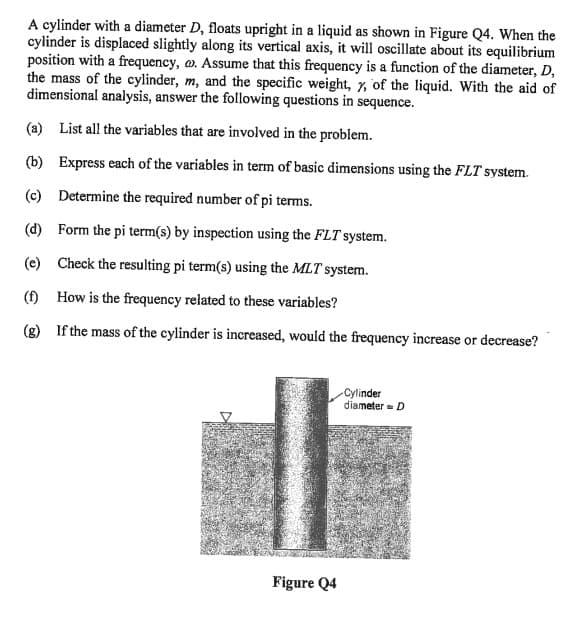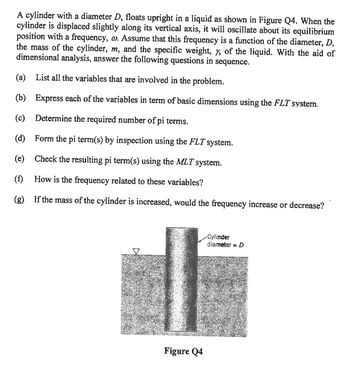A cylinder with a diameter D, floats upright in a liquid as shown in Figure Q4. When the Cylinder is displaced slightly along its vertical axis, it will oscillate about its equilibrium position with a frequency, a. Assume that this frequency is a function of the diameter, D, the mass of the cylinder, m, and the specific weight, 7, of the liquid. With the aid of dimensional analysis, answer the following questions in sequence. 11.
A cylinder with a diameter D, floats upright in a liquid as shown in Figure Q4. When the Cylinder is displaced slightly along its vertical axis, it will oscillate about its equilibrium position with a frequency, a. Assume that this frequency is a function of the diameter, D, the mass of the cylinder, m, and the specific weight, 7, of the liquid. With the aid of dimensional analysis, answer the following questions in sequence. 11.
Elements Of Electromagnetics
7th Edition
ISBN:9780190698614
Author:Sadiku, Matthew N. O.
Publisher:Sadiku, Matthew N. O.
ChapterMA: Math Assessment
Section: Chapter Questions
Problem 1.1MA
Related questions
Question

Transcribed Image Text:A cylinder with a diameter D, floats upright in a liquid as shown in Figure Q4. When the
cylinder is displaced slightly along its vertical axis, it will oscillate about its equilibrium
position with a frequency, o. Assume that this frequency is a function of the diameter, D,
the mass of the cylinder, m, and the specific weight, y, of the liquid. With the aid of
dimensional analysis, answer the following questions in sequence.
(a) List all the variables that are involved in the problem.
(b) Express each of the variables in term of basic dimensions using the FLT system.
(c) Determine the required number of pi terms.
(d)
Form the pi term(s) by inspection using the FLT system.
(e) Check the resulting pi term(s) using the MLT system.
(f) How is the frequency related to these variables?
(g)
If the mass of the cylinder is increased, would the frequency increase or decrease?
D
Figure Q4
Cylinder
diameter D
Expert Solution
This question has been solved!
Explore an expertly crafted, step-by-step solution for a thorough understanding of key concepts.
This is a popular solution!
Trending now
This is a popular solution!
Step by step
Solved in 2 steps with 2 images

Follow-up Questions
Read through expert solutions to related follow-up questions below.
Follow-up Question
e) f) g)

Transcribed Image Text:A cylinder with a diameter D, floats upright in a liquid as shown in Figure Q4. When the
cylinder is displaced slightly along its vertical axis, it will oscillate about its equilibrium
position with a frequency, o. Assume that this frequency is a function of the diameter, D,
the mass of the cylinder, m, and the specific weight, y, of the liquid. With the aid of
dimensional analysis, answer the following questions in sequence.
(a) List all the variables that are involved in the problem.
(b) Express each of the variables in term of basic dimensions using the FLT system.
(c) Determine the required number of pi terms.
(d)
Form the pi term(s) by inspection using the FLT system.
(e) Check the resulting pi term(s) using the MLT system.
(f) How is the frequency related to these variables?
(g)
If the mass of the cylinder is increased, would the frequency increase or decrease?
D
Figure Q4
Cylinder
diameter D
Solution
Knowledge Booster
Learn more about
Need a deep-dive on the concept behind this application? Look no further. Learn more about this topic, mechanical-engineering and related others by exploring similar questions and additional content below.Recommended textbooks for you

Elements Of Electromagnetics
Mechanical Engineering
ISBN:
9780190698614
Author:
Sadiku, Matthew N. O.
Publisher:
Oxford University Press

Mechanics of Materials (10th Edition)
Mechanical Engineering
ISBN:
9780134319650
Author:
Russell C. Hibbeler
Publisher:
PEARSON

Thermodynamics: An Engineering Approach
Mechanical Engineering
ISBN:
9781259822674
Author:
Yunus A. Cengel Dr., Michael A. Boles
Publisher:
McGraw-Hill Education

Elements Of Electromagnetics
Mechanical Engineering
ISBN:
9780190698614
Author:
Sadiku, Matthew N. O.
Publisher:
Oxford University Press

Mechanics of Materials (10th Edition)
Mechanical Engineering
ISBN:
9780134319650
Author:
Russell C. Hibbeler
Publisher:
PEARSON

Thermodynamics: An Engineering Approach
Mechanical Engineering
ISBN:
9781259822674
Author:
Yunus A. Cengel Dr., Michael A. Boles
Publisher:
McGraw-Hill Education

Control Systems Engineering
Mechanical Engineering
ISBN:
9781118170519
Author:
Norman S. Nise
Publisher:
WILEY

Mechanics of Materials (MindTap Course List)
Mechanical Engineering
ISBN:
9781337093347
Author:
Barry J. Goodno, James M. Gere
Publisher:
Cengage Learning

Engineering Mechanics: Statics
Mechanical Engineering
ISBN:
9781118807330
Author:
James L. Meriam, L. G. Kraige, J. N. Bolton
Publisher:
WILEY